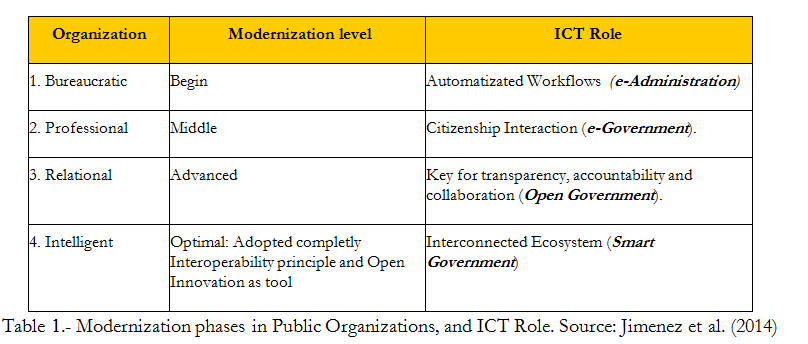E-Government Interoperability: Linking Open and Smart Government
The journal IEEE Computer Society “Computer” published this in the October 2014 special issue on e-Government Interoperability under the title “E-Government Interoperability: Linking Open and smart Government.” It is accessible through the following link.
The idea of the table (see below), which stands in relation to the article, is that there would be a 4th type of public organization (Intelligent), after the Relational, based in the optimized IT adoption degree, and how it can transform the public organization as well as society. This new 4th “refined” public organization level, would be achieved as a result of IT as a tool that is used in perfect harmony with: a) Open Government b) the Open Innovation in public organization and c) a maximized Interoperability Principle (with its dimensions –semantic, technical, organizational, etc- and its governance). Interoperability is to be achieved in an optimized state, always looking for the best way to serve citizens and society. The concept of “smart” cities (or “smart” territories) would have all these factors included, that could be identified with the concept of Smart Government, where interoperability not only is key to connect systems and technologies, but also in relation to its organizational dimension or governance.
This 4th stage was born as a result of a process of evolution in public organizations, where IT adoption not only transforms organizations internally, but that a well adopted technology can also be a helpful tool to achieve the goals of public organizations and society that governs (efficiency, effectiveness, transparencyAccording to OGP’s Articles of Governance, transparency occurs when “government-held information (including on activities and decisions) is open, comprehensive, timely, freely available to the pub... More, citizen-centric, etc). We can see from the table that e-Administration started with the IT adoption addressed to automatize workflows (1st stage).
Later, the e-Government stage (2nd stage) includes interaction between citizens through the use of electronic tools, and bi-directional flows of information allowing citizens to use e-services.
Following this, technologies contribute and facilitate the move to a 3rd stage -Open Government-, allowing a high degree of the governance paradigm and not only through the use of e-services. And, then, the next it would be the 4th stage explained.
These stages are incremental where IT transforms the public organizations at the same time as they produce better services to citizens.

